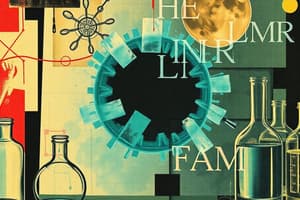Podcast
Questions and Answers
What determines the position of the 1H NMR signal?
What determines the position of the 1H NMR signal?
- The temperature of the NMR spectrometer
- The number of protons in the compound
- The molecular weight of the compound
- The electronegativity of the surrounding atoms (correct)
Why does 1-nitropropane have three 1H NMR signals?
Why does 1-nitropropane have three 1H NMR signals?
- As a result of the low temperature of the NMR spectrometer
- Due to the presence of three different kinds of protons (correct)
- Because of the number of nitro groups in the compound
- Because of the high molecular weight of the compound
In the 1H NMR spectrum, which protons show a signal at the highest frequency in 1-nitropropane?
In the 1H NMR spectrum, which protons show a signal at the highest frequency in 1-nitropropane?
- The protons adjacent to the halogen
- The protons adjacent to fluorine
- The protons farthest from the nitro group
- The protons closest to the nitro group (correct)
What effect does increasing electronegativity of the halogen have on the 1H NMR signal?
What effect does increasing electronegativity of the halogen have on the 1H NMR signal?
What determines the position of the signal for the methylene protons adjacent to the halogen in alkyl halides?
What determines the position of the signal for the methylene protons adjacent to the halogen in alkyl halides?
Study Notes
Factors Determining 1H NMR Signal Position
- Position of 1H NMR signal is influenced by chemical environment, including electronegativity of nearby atoms and steric effects.
- Shielding and deshielding effects by electronegative atoms or groups shift the signal; deshielded protons resonate at lower frequency (downfield), while shielded protons resonate at higher frequency (upfield).
1-Nitropropane and its Signals
- 1-nitropropane has three distinct 1H NMR signals due to the presence of three different types of hydrogen atoms in the molecule: one on the primary carbon, two on the secondary carbon, and an integration indicating their unique environments.
- The different protons experience varying degrees of electron density based on their proximity to the nitro group and other substituents.
Highest Frequency Protons in 1-Nitropropane
- In 1-nitropropane, the protons on the carbon atom adjacent to the nitro group show a signal at the highest frequency (downfield) due to deshielding effects of the electronegative nitro functional group.
Effect of Halogen Electronegativity on 1H NMR
- Increasing electronegativity of halogens increases the deshielding effect on adjacent protons, leading to downfield shifts in the signals observed in the 1H NMR spectrum.
Methylene Protons Adjacent to Halogen in Alkyl Halides
- The position of the signal for methylene protons adjacent to a halogen is primarily determined by the electronegativity of the halogen and its ability to withdraw electron density, influencing the chemical shift in the spectrum.
Studying That Suits You
Use AI to generate personalized quizzes and flashcards to suit your learning preferences.
Description
Test your understanding of NMR spectroscopy and the relative positions of 1H NMR signals with this quiz on 1-nitropropane. Explore how the electron-withdrawing nitro group affects proton shielding and signal frequency, and enhance your knowledge of NMR spectra interpretation.




